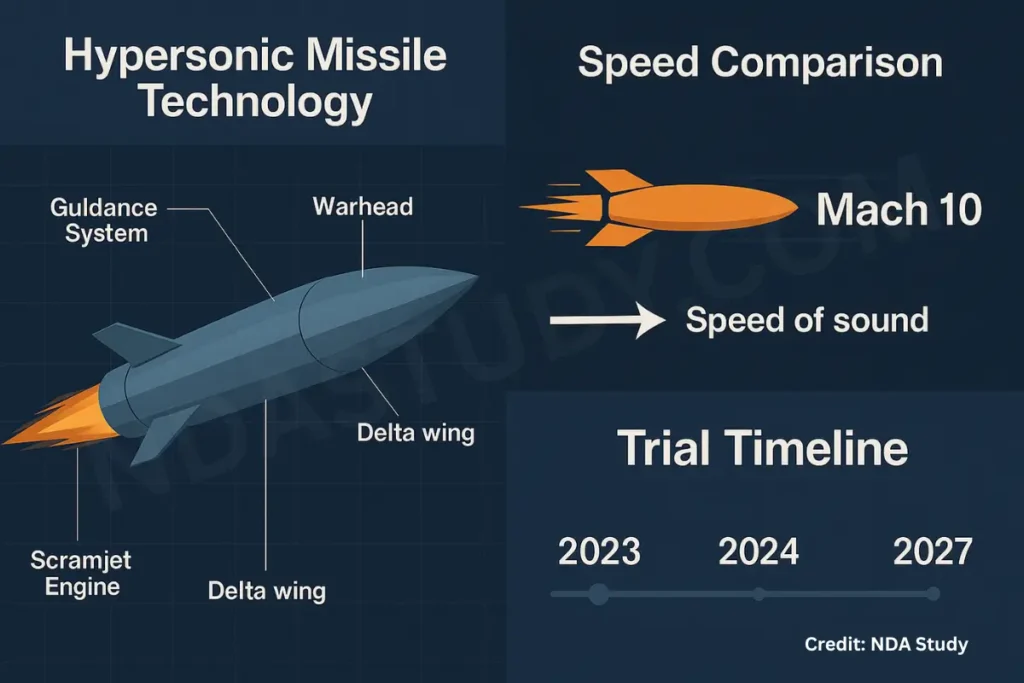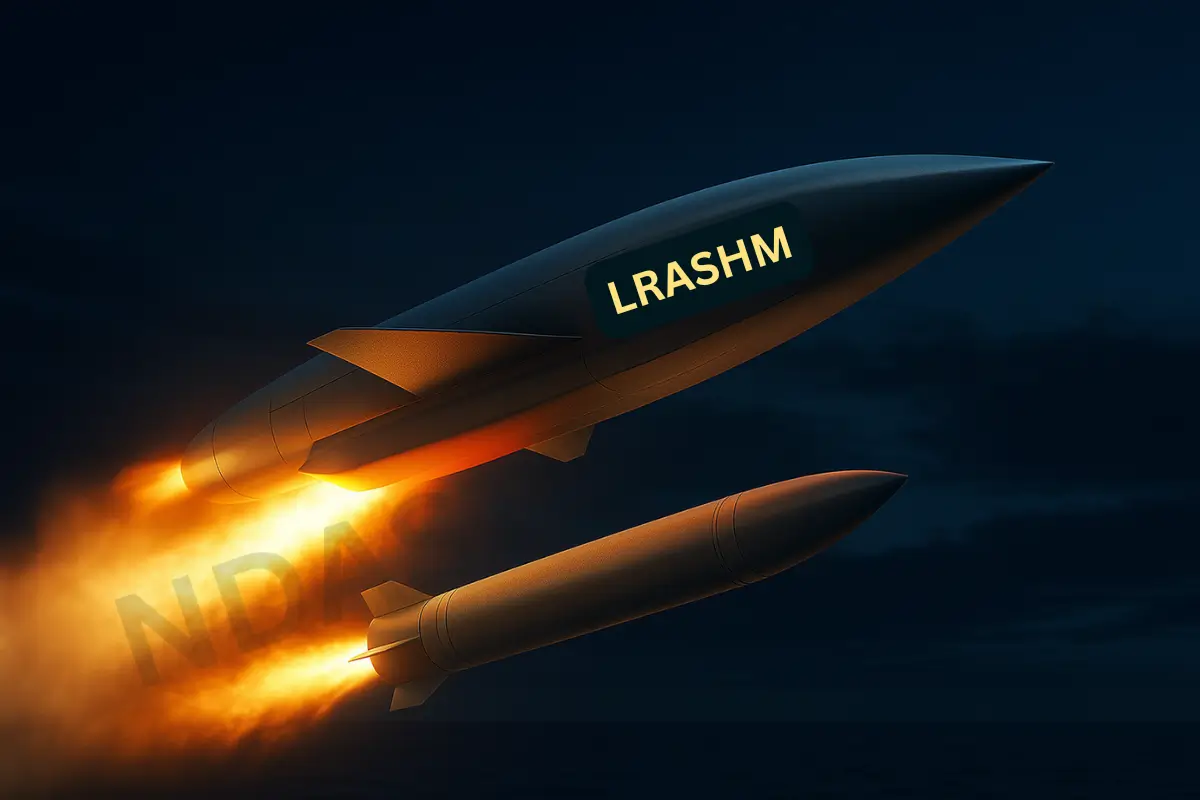India is set to make history as the DRDO to complete LRAShM hypersonic missile trials by 2027, marking a transformative leap in the nation’s defence capabilities. Recent DRDO missile tests have demonstrated the Long-Range Anti-Ship Missile (LRAShM) achieving Mach 10 missile speed—over 12,000 km/h—placing India among the world’s leading hypersonic powers. This cutting-edge missile, a product of indigenous missile development under the Make in India defence initiative, boasts a range exceeding 1,500 km and is engineered for the Indian Navy’s next-generation maritime strike roles.
The DRDO hypersonic missile program is a key component of the modernisation efforts of the Indian Armed Forces and serves as a powerful symbol of India’s strategic deterrence in the Indian Ocean Region. As the world closely monitors the trials of the LRAShM hypersonic missile scheduled for 2027, young aspirants and defence enthusiasts are witnessing the dawn of a new era in India’s hypersonic missile initiatives—one where speed, precision, and innovation are redefining national security and enhancing India’s global standing.
DRDO to Complete LRAShM Hypersonic Missile Trials by 2027
India’s defence sector is witnessing a historic leap as the DRDO to complete LRAShM hypersonic missile trials by 2027, marking a new era of indigenous missile development and strategic deterrence. The Long-Range Anti-Ship Missile (LRAShM), a hypersonic glide vehicle (HGV), has already achieved Mach 10 missile speed—over 12,000 km/h—during its successful test on November 16, 2024, from Dr. APJ Abdul Kalam Island. This missile, designed and developed by DRDO’s Dr. APJ Abdul Kalam Missile Complex in Hyderabad with industry partners, can strike targets over 1,500 km away and perform complex terminal manoeuvres, making it nearly impossible to intercept.
Indigenous Breakthroughs & User Impact
The LRAShM stands out for its fully indigenous design, embodying the Make in India defence initiative and the nation’s commitment to self-reliance. Its delta-wing Hypersonic Glide Vehicle (HGV) configuration, advanced solid propellant rocket stages, and adaptive flight path enable multi-role deployment, including anti-ship and land attack capabilities, across all branches of the Indian Armed Forces. The cold-launched, containerised missile is designed for both land and naval platforms, with future variants planned for the Integrated Rocket Force.
For defence enthusiasts and young professionals, this development exemplifies how India’s hypersonic missile program is transforming national security. The LRAShM not only enhances the Indian Navy’s maritime strike capabilities but also serves as a credible deterrent in the Indian Ocean Region, particularly against carrier groups and emerging regional threats. As the Defence Research and Development Organisation (DRDO) advances the hypersonic missile program toward its 2027 milestone, it represents a significant achievement in technological innovation, indigenous excellence, and strategic foresight, empowering India’s defence ecosystem and inspiring the next generation of defence leaders.
Recent Developments & Trial Timeline
India’s hypersonic ambitions reached a new milestone on November 16, 2024, when the Defence Research and Development Organisation (DRDO) successfully tested the Long-Range Anti-Ship Missile (LRAShM) from Dr. APJ Abdul Kalam Island, Odisha. This inaugural flight marked a historic leap in the nation’s missile capabilities, with the LRAShM achieving a blistering Mach 10 speed—over 12,000 km/h—far surpassing initial estimates and placing India among the world’s fastest hypersonic missile developers. The missile demonstrated not only pinpoint terminal accuracy but also executed complex manoeuvres, confirming the reliability of its delta-wing hypersonic glide vehicle (HGV) design.
| Year | Milestone |
|---|---|
| 2019 | Prior HSTDV test validates scramjet tech at Mach 6. |
| 2023 | Scaled-down LRAShM model unveiled; subsystem testing begins . |
| Nov 16, 2024 | Scaled-down LRAShM model unveiled; subsystem testing begins. |
| Jan–Apr 2025 | First full-scale flight test from Abdul Kalam Island, coast of Odisha: covered ~1,400–1,500 km; demonstrated terminal manoeuvres. |
| By 2027 | DLR testing of scramjet combustor ground tests, marking crucial propulsion milestones. |
In June 2025, Dr. Samir V. Kamat, the head of DRDO, announced that all major trials for the LRAShM hypersonic missile will finish by 2027. This progress strengthens India’s role as a leader in missile technology. Dr. Kamat highlighted that the LRAShM program shows India’s dedication to homegrown innovation and self-reliance. The missile is key to enhancing the Indian Navy’s capabilities and serves multiple branches of the military.
A major factor in the LRAShM’s success is its advanced propulsion system. This includes a two-stage solid rocket booster and a hypersonic sustainer engine, building on earlier scramjet tests from the Hypersonic Technology Demonstrator Vehicle (HSTDV), which reached Mach 6 in 2020. The LRAShM achieves Mach 10, demonstrating significant advancements in propulsion, heat management, and material science, such as new ceramic barriers and composite structures that can withstand extreme conditions.
Intresting Facts: Must know
1. India’s LRAShM missile achieved an unprecedented Mach 10 speed during its November 2024 test—surpassing global expectations and rivaling Russia’s Kinzhal and China’s DF-ZF hypersonic weapons. This breakthrough positions India among the world’s fastest hypersonic missile developers, showcasing cutting-edge indigenous propulsion and thermal management technology.
2. Unlike traditional ballistic missiles, LRAShM’s hypersonic glide vehicle (HGV) can maneuver unpredictably at lower altitudes, enabling it to evade advanced missile defense radars and interceptors, making it nearly impossible to shoot down. This adaptive flight path capability is a game-changer in modern naval warfare and strategic deterrence.
The LRAShM’s development is part of the Make in India defence initiative, led by DRDO’s Dr. APJ Abdul Kalam Missile Complex in Hyderabad, along with industry partners. Its cold-launched, containerised system, advanced flight control, and multiple payload options make it useful for both anti-ship and land-attack missions with a range of over 1,500 km.
Defence Minister Rajnath Singh called the November 2024 test a “historic moment” and congratulated DRDO, the armed forces, and industry contributors. Defence analysts point out that the LRAShM’s speed, accuracy, and manoeuvrability, driven by local innovation, help India tackle new threats, especially in the Indian Ocean Region and beyond. As DRDO prepares for the final phase of trials, the LRAShM is a symbol of technological progress and strategic planning, encouraging young people interested in defence and supporting India’s goal of self-reliance and modernisation.
Advanced Features & Strategic Impact
The Defence Research and Development Organisation (DRDO) plans to complete trials of the Long-Range Anti-Ship Missile (LRAShM) by 2027. This is a key moment for India’s missile development and shows the country’s ability to create advanced defence technology. The LRAShM, first tested in 2023 and again successfully on November 16, 2024, is designed to improve India’s ability to strike targets. It uses a delta-wing hypersonic glide vehicle (HGV) that is launched from a strong booster rocket.

Key Indigenous Features:
- The LRAShM launches safely from a sealed container. It uses small thrusters to control its position before the solid rocket motor starts. This process ensures reliable deployment, even from naval ships.
- The missile features a two-stage propulsion system that includes a booster and a hypersonic sustainer engine, allowing it to achieve speeds of up to Mach 10 (over 12,000 km/h). Its delta-wing hypersonic glide vehicle (HGV) enables complex terminal manoeuvres and adaptive flight paths, which make it nearly impossible for current missile defence systems to intercept.
- The missile’s cruciform design, short aerodynamic surfaces, and triangular aft fins ensure both stability and manoeuvrability at hypersonic speeds, while also minimising aerodynamic drag for optimal range and efficiency.
- With a proven range of at least 1,500 km, the LRAShM can carry various warhead configurations, providing flexibility for both anti-ship and land-attack missions across all branches of the Indian Armed Forces.
Also Read:
Strategic Impact & User Relevance:
- The LRAShM (Long Range Anti-Ship Missile) is a direct response to regional threats, particularly advanced systems deployed by adversaries such as China’s DF-17 hypersonic glide vehicle. It is designed to ensure that India’s armed forces maintain operational superiority in highly contested environments, including the Indian Ocean Region and the Tibetan Plateau.
- Its hypersonic speed and manoeuvrability enable it to penetrate advanced air defence systems and strike strategic targets, including enemy airbases and command centres, far beyond India’s borders.
- India’s missile development, led by the DRDO’s Dr. APJ Abdul Kalam Missile Complex and its industry partners, shows the success of the Make in India defence initiative. This effort strengthens India’s position as one of the world’s most advanced military powers.
For people interested in defence and young professionals, the journey of the LRAShM from idea to near-launch shows how India is innovating and planning strategically. As India gets ready to finish the last trials by 2027, the LRAShM represents national pride, technological success, and a strong defence against new regional threats. This initiative empowers the next generation to help modernise India’s defence and promote self-reliance.
Future Prospects & Challenges
The Defence Research and Development Organisation (DRDO) is set to complete trials for the Long Range Air-to-Strike Hypersonic Missile (LRAShM) by 2027. This achievement will position India among the select few nations with operational hypersonic missile capabilities, marking a significant advancement in indigenous defence technology. Following the anticipated completion of all major tests by 2027, the LRAShM is expected to be inducted into service and deployed by the Indian Armed Forces shortly thereafter. This development will greatly enhance the maritime and land strike capabilities of the Indian Navy, Army, and Air Force.
Induction Timeline & Integration
- Post-Trials Induction: Once the trials conclude, the LRAShM is expected to be rapidly integrated into frontline units, starting with the Indian Navy’s warships and coastal defence batteries, and later adapted for land-based and air-launched variants.
- Multi-Role Deployment: The missile’s modular design allows for both anti-ship and land-attack missions, supporting India’s vision for a future Integrated Rocket Force.
Export & International Collaboration
- Export Potential: As India’s defence export ambitions expand, the LRAShM’s domestic origins and advanced capabilities position it as a compelling option for allied nations pursuing hypersonic technology, particularly in Southeast Asia and Africa.
- Collaborating with domestic industries and potential partnerships with allied nations could enhance technological advancements and expand global reach.
Technological Challenges & DRDO’s Roadmap
- Technical Hurdles: Consistently achieving Mach 10 speeds, as well as terminal manoeuvrability and survivability against advanced air defences, remains an ongoing challenge. Advances in materials science, thermal management, and scramjet propulsion require sustained research and development.
- R&D Commitment: DRDO’s roadmap features ongoing upgrades, iterative testing, and the application of insights from the Hypersonic Technology Demonstrator Vehicle (HSTDV) program to enhance guidance, navigation, and control systems.
- Policy Support: The success of the LRAShM highlights the need for robust policy support for the Make in India defence initiative, ensuring adequate funding, skilled talent, and active industry participation for achieving long-term self-reliance.
Author’s Words: What’s Next
India is making strong progress in developing hypersonic missile technology, placing it among the top defence innovators in the world, alongside the US, Russia, and China. The Defence Research and Development Organisation (DRDO) plans to finish trials of the Long-Range Anti-Ship Missile (LRAShM) by 2027. This is an important technological step and shows a significant advancement in India’s defence capabilities. The LRAShM is being built under the Make in India initiative, highlighting India’s skills in research and engineering.
As India prepares to use the LRAShM, it is likely to have a big impact on national security and regional power. The LRAShM will support India’s strategic defence, offering great speed and movement. It will also help modernise the Indian Armed Forces. This development shows how ongoing innovation and government support can benefit the defence sector.
Stay tuned for updates as India approaches operational deployment, bolstering national defence and inspiring a new generation in technology and strategy.
Stay Tuned & Stay Connected!












